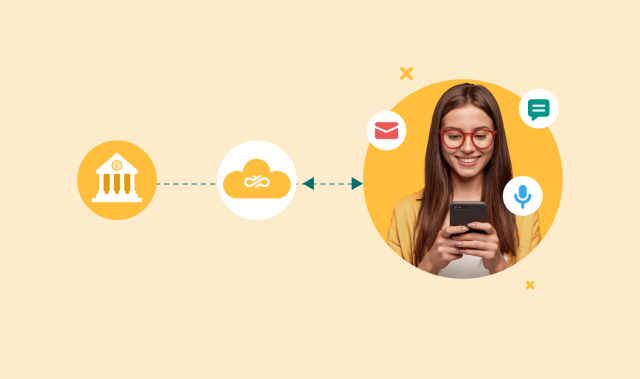In this article:
- What is multichannel customer engagement?
- How does multichannel work?
- What is omnichannel customer engagement?
- How does omnichannel work?
- Comparing omnichannel and multichannel marketing
- What are the benefits of integrated channels?
- Omnichannel vs. multichannel: Which is best?
- Future-proofing your organization
In a time where you can get nearly anything you need quickly by using your phone, people don’t just want convenience — they demand it. When they’re dealing with a brand, they expect interactions to be easy and seamless. Over the last few years, brands have turned to multichannel and omnichannel communication to better meet that demand.
Multichannel and omnichannel strategies let people interact with a brand on many channels. The two differ when a customer wants to move across two or more channels.
While a multichannel marketing strategy covers several different channels, those channels are basically independent of each other. If your customers only used one channel, this wouldn’t be an issue, but people tend to move across channels as they learn more about a brand.
With an omnichannel marketing system, a unified sales and marketing strategy keeps engaging customers wherever they are, regardless of channel. By integrating these channels, customers can get a more unified experience as there are fewer drop-offs on different touchpoints. This frictionless approach offers a better experience and better conversions.
So if you want to put your customers first and make better data-driven decisions about your marketing, let’s start by learning more about the multichannel vs. omnichannel divide.
What is multichannel customer engagement?
Multichannel customer engagement focuses on reaching customers in their preferred channel. The goal is to offer personalized information that promotes a brand’s products.
Pros of multichannel
- Reaching customers where they are
- Clear paths of communication
- Take advantage of benefits different channels have to offer
Cons of multichannel
- Product-focused
- Difficult to change between communication channels
- Each new channel requires new assets and strategies
- Not ideal for businesses with many channels who want to provide a great UX across a large number of channel
How does multichannel work?
When a customer opts into a channel that is a part of a multichannel customer engagement system, they’ll receive notifications and offers only through that channel, email, or SMS. Multichannel gives your company a wide reach because it’s available on many different platforms, but each channel basically exists on its own.
Put another way, if a customer opts in on one channel, then joins another, they’ll need to start a new conversation. While that journey may be more in line with what they want, it’s frustrating because they’ll need to rehash information or make assumptions about previous conversations with your company.
What is omnichannel customer engagement?
Where multichannel customer engagement separates customer interactions with a brand, omnichannel customer engagment combines and keeps tabs on customers across all channels. This builds a more consistent experience throughout the customer journey and can help you create personalized campaigns based on purchases and conversation data.
The result? Higher engagement, improved customer loyalty, and increased conversions.
Pros of omnichannel
- Customer-focused
- Flexible communication options
- Seamless transitions between channels
- Easily scalable
Cons of omnichannel
- Not always necessary for businesses whose customers use one or two communication channels to interact.
How does omnichannel work?
Omnichannel is all about creating a seamless customer experience by integrating branding, messaging, and both online and offline touchpoints across any channel they use. It's like making sure everything flows smoothly as consumers move through the sales process, connecting all channels, platforms and devices.
Nowadays, consumers have so many ways to connect with brands, like social media or calling customer service. With omnichannel marketing, the focus is on putting the consumer first. It's about providing a positive and consistent experience across all channels.
Comparing omnichannel and multichannel marketing
Here's a look at how omnichannel and multichannel marketing function.

Omnichannel marketing is a customer-centric approach that seamlessly connects all channels, platforms and devices. Multichannel marketing is a product-focused approach that users the customer’s preferred communication channel.
Both strategies are pretty great. But, if we want to know which is better, let's see how they compare in two key areas: customer engagement and customer experience.
Customer engagement
With a multichannel strategy, the goal is to give your brand more opportunities to connect with your customers and increase reach - each channel is optimized for conversion and engagement. But if a customer engaged with more than one of these channels, the experience might not be seamless.
Because an omnichannel strategy puts the customer first, it gives them a more tailored, continuous, and connected experience no matter which channels they’re on.
Putting your customer at the center of the experience leads to better results. With an omnichannel strategy, you’re creating a smooth path for customers to interact with your brand, from initial engagement to purchase to support.
Customer experience
Customer experience in a multichannel system is all about sharing your brand’s message and the benefits of your product with as many customers as possible across as many channels as possible with the ultimate goal of conversions.
An omnichannel customer experience is built around understanding the client, then creating a better experience across platforms. By making customers the center of your marketing and sales efforts, you can create better experiences.
This kind of customer experience offers the convenience people demand while helping your team members understand customer needs.
What are the benefits of integrated channels?
With several tools available for omnichannel marketing, there are many benefits of creating and using an integrated channel strategy.
You can create a more consistent customer experience across channels, gain and implement data-driven insights, and increase marketing ROI.

Seamless and consistent customer experience
Uniting and routing traffic through a single point creates a seamless, omnichannel experience. A single API with marketing, conversational AI, and live chat tools makes it easy to deliver consistent and satisfying experiences across a customer’s entire journey.
No matter which channels a customer is using, they can pick up where they left off because your channels work together.
Some of the tools that can allow for a a great customer experience by supporting a wide range of channels include:
- Personalized messaging campaigns
- Chatbots
- Voicebots
- Real-time conversation solutions
Data-driven insights power customer engagements
With an integrated system, you can use data gathered to better meet customer needs. This means that you can build campaigns based on actual data and behavior. Such personalized campaigns improve brand loyalty, convert better, and have higher levels of engagement.
Increase ROI with the right tools
Another great benefit of an integrated or omnichannel approach to your marketing and customer engagement strategy is increased ROI. Building a solution that allows customers to engage in the ways that they’re most comfortable with, doesn’t just mean greater customer satisfaction and retention is a possibility, it's inevitable.

Build powerful customer relationships
The suite of Sinch marketing tools has everything you need to gain, grow, and maintain relationships with your customers. Create consistent messaging and branding that carries across channels, and naturally nurture a customer’s journey.
Supercharge your sales using customer data
Integrating customer data across all of your marketing, support, and sales channels means better sales figures. Omnichannel sales are less likely to slip away thanks to many client touch points. Plus, every sale creates another opportunity to learn more about your customers and when you know your customers well, it’s easier to meet their needs.
Increase engagement with conversational marketing
Conversational marketing is an excellent option if you’re trying to create a streamlined and seamless experience for customers. This extends into how you support them during the exploration and buying process.
Omnichannel customer support is more efficient than simple outbound marketing because you are available to answer questions at the moment when your audience’s interest has spiked – the moment that they’re interacting with one of your marketing messages.
And if they move through different touchpoints and come back with more questions later, you can pick up the conversation as if it were on the same channel as before.
Omnichannel vs. multichannel: Which is best?
Retail
Omnichannel retail is all about providing a seamless and interconnected experience for customers across various touchpoints. This includes channels like email, social media, texts, apps, phone calls, and ads. The goal is to streamline the entire customer journey, from initial contact to making a purchase and receiving ongoing support. Studies show that omnichannel shoppers tend to spend more, making the adoption of an omnichannel system crucial for businesses.
While multichannel strategies involve using multiple channels, they often operate independently without working together. On the other hand, omnichannel strategies integrate channels to create a cohesive customer experience.
Winner: omnichannel
e-commerce
When it comes to e-commerce, you need to do more than just be present on different channels. Multichannel e-commerce offers various channels for customers, but they work independently. Omnichannel e-commerce, on the other hand, takes it up a notch. It creates a seamless and connected experience for customers across all channels, ensuring their journey is smooth and uninterrupted.
Imagine a customer reaching out to you on social media, exploring your website, and subscribing to your emails. With an omnichannel approach, you can continue the conversation effortlessly, providing personalized recommendations and exclusive discounts. It's convenient for customers, drives traffic and sales, and helps you gather valuable insights into their preferences. Plus, it fosters loyalty by delivering a consistent and trustworthy experience. This wouldn't be possible with a multichannel approach
Winner: omnichannel
Future-proofing your organization
For your business to continue growing, it’s more important than ever to adapt and meet your customers where they are. An omnichannel marketing strategy is perhaps the most important step to take in preparation for how your customers will communicate with your brand today and tomorrow.
Now that you have a better understanding of the difference between omnichannel and multichannel customer engagement, feel free to check out our CX trends report to learn how these strategies can help meet customer expectations. If you’re ready to start building your omnichannel customer engagement system, Sinch makes it easy. Reach out to us today to learn more.
Looking into CPaaS providers? Wondering which vendors are best positioned to support your present and future communications use cases and what you should consider when choosing a CPaaS solution?
Get a copy of the 2023 Gartner® Magic Quadrant™ for Communications Platform as a Service (CPaaS) to find out.




